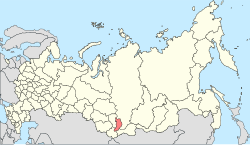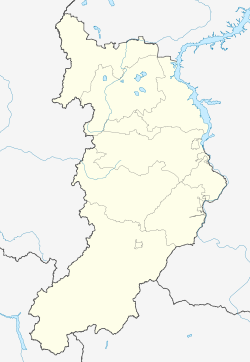Abakan
| Abakan (English) Абакан (Russian) Ағбан (Khakas) |
|
|---|---|
| - City - | |
 Abakan City Administration building |
|
 Location of the Republic of Khakassia in Russia |
|
|
|
|
|
|
|
|
|
|
| Anthem | none |
| City Day | Second to last Saturday in August |
| Administrative status (as of May 2014) | |
| Country | Russia |
| Federal subject | Republic of Khakassia |
| Administratively subordinated to | City of Abakan |
| Capital of | Republic of Khakassia |
| Administrative center of | City of Abakan |
| Municipal status (as of November 2014) | |
| Urban okrug | Abakan Urban Okrug |
| Administrative center of | Abakan Urban Okrug |
| Head | Nikolay Bulakin |
| Representative body | Council of Deputies |
| Statistics | |
| Population (2010 Census) | 165,214 inhabitants |
| - Rank in 2010 | 109th |
| Population (January 2014 est.) | 173,200 inhabitants |
| Time zone | KRAT (UTC+07:00) |
| Founded | 1675 |
| City status since | April 30, 1931 |
| Postal code(s) | 655000–655012, 655014–655019, 655022, 655400, 655899, 655961, 655965, 655966 |
| Dialing code(s) | +7 3902 |
|
|
|
| on | |
Abakan (Russian: Абака́н; IPA: [ɐbɐˈkan]; Khakas: Ағбан, Ağban) is the capital city of the Republic of Khakassia, Russia, located in the central part of Minusinsk Depression, at the confluence of the Yenisei and Abakan Rivers. As of the 2010 Census, it had a population of 165,214—a slight increase over 165,197 recorded during the 2002 Census and a further increase from 154,092 recorded during the 1989 Census.
Abakansky ostrog (Абаканский острог), also known as Abakansk (Абаканск), was built at the mouth of the Abakan River in 1675. In the 1780s, the selo of Ust-Abakanskoye (Усть-Абаканское) was established in this area. It was granted town status and given its current name on April 30, 1931.
In 1940, Russian construction workers found ancient ruins during the construction of a highway between Abakan and Askiz. When the site was excavated by Soviet archaeologists in 1941–1945, they realized that they had discovered a building absolutely unique for the area: a large (1500 square meters) Chinese-style, likely Han Dynasty era (206 BCE–220 CE) palace. The identity of the high-ranking personage who lived luxuriously in Chinese style, far outside of the borders of the Han Empire, has remained a matter for discussion ever since. Russian archaeologist L.A. Yevtyukhova surmised, based on circumstantial evidence, that the palace may have been the residence of Li Ling, a Chinese general who had been defeated by the Xiongnu in 99 BCE, and defected to them as a result. While this opinion has remained popular, other views have been expressed as well. More recently, for example, it was claimed by A.A. Kovalyov as the residence of Lu Fang (), a Han throne pretender from the Guangwu era.
...
Wikipedia



